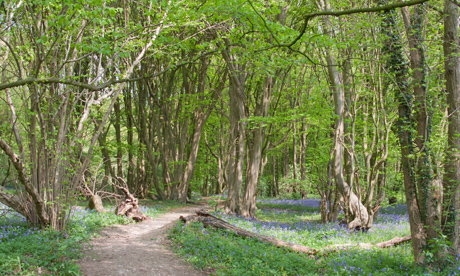
One of the best quintessentially British spring sights is a carpet of blooming bluebells. Here's where to spot them when they flourish
Heartwood Forest will become the largest new native forest in England once the Woodland Trust has completed its planting programme, which will see 600,000 trees planted by volunteers. The 850 acres are home to both ancient woodland and vast carpets of beautiful bluebells.
Prominent on the summits of Duncliffe Hill, just west of Shaftesbury, and rising out of Blackmoor Vale, this large ancient woodland site can be spotted for miles around. A designated site of nature conservation interest, it has a rich mix of woodland species, including what are reported to be the oldest inhabitants of Dorset: a scattering of coppice stools of small-leaved limes.
Ashenbank Wood is comprises ancient woodland with a varied history. During World War II the RAF stationed five camps on site to accommodate personnel stationed at the Gravesend Airfield, with some structures still visible today.
Usually at this time of year there are prolific shows of bluebells scattered across the forest floor for visitors to meander through.
Coed Cefn occupies a hilltop overlooking Crickhowell, a small pretty Welsh town, which lies one mile to the west. Most of the woodland canopy consists of blocks of oak and beech with self-sown ash predominating on the southern side. The woodland floor is dominated by bluebells in spring.
The Woodland Trust's largest wood and described as the highlands in miniature; Glen Finglas has all the contrasts of mountains and water but on a much more intimate scale. Woodland historians believe that Glen Finglas is home to one of the largest collections of ancient trees in Scotland. And, of course, an impressive display of bluebells.
Brede High Woods is situated six miles north of Hastings in the High Weald Area of Outstanding Natural Beauty. Visitors to Brede compare it to walking through ten different woods on one site. It is special for its rare green hellebores and wild service trees, but also for hobby, woodcock, nightingales and buzzards, glowworms, great crested newts, lampreys, dormouse, badgers and fallow deer.
Set in a 350ft gorge on the edge of Grewelthorpe, the site was bought in 1731 by John Aislabie, famous for his landscaping work at nearby Fountains Abbey and Studley Royal. Following years of decline, the site has been given a new lease of life in the last few decades and teems with a thriving range of wild plant communities, including a spectacular spread of bluebells every year.
Prehen Wood sits quietly on the east bank of the River Foyle and, dating back as far as 1600, has seen centuries come and go. Visitors to this area will be overwhelmed by Prehen’s natural beauty. The more privileged visitor may even catch a glimpse of the endangered red squirrel, while bird inhabitants include the sparrowhawk and long-eared owl.
Credenhill Park Wood is a local landmark with historical and environmental importance, having been designated a Scheduled Ancient Monument and Special Wildlife Site. The tranquil paths among the trees give the visitor views of small-leaved limes, early purple orchids, fragrant wild garlic and bluebells.
The Iron Age hill fort that forms an integral part of the site is one of the largest hill forts in England, and is thought to have been an Iron Age tribal capital.